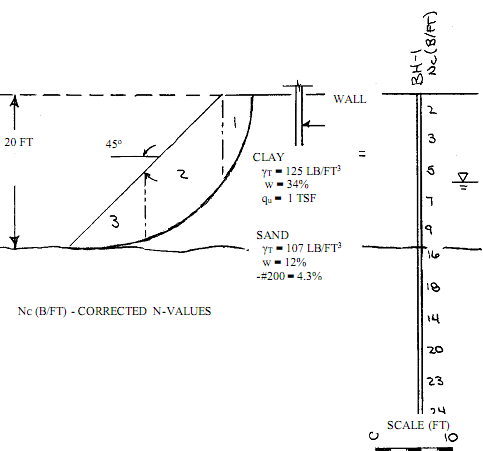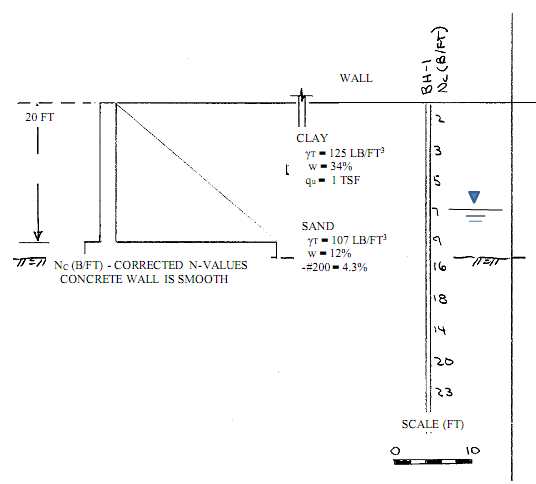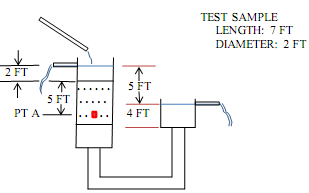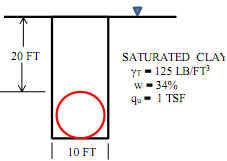1. In addition to the bearing capacity of the building foundation, the designer of record must evaluate the stability of the slope adjacent to the structure. Using the fellenius method of slices, estimate the factor of safety of the slope against sliding. Use the table on page 2 as a design guide.

2a. What is the design factor of safety for the long-term stability of slopes:__________________. Source:______________________
2b. Is the factor of safety against slope movement adequate to construct the building at the top of the slope?____________
3. Is the sand layer below the clay in a
- confined - artesian
- unconfined - restrained
pressure head condition? Choose wisely
4. As the designer, you are concerned about the long-term stability of the slope. As such, you recommend that the developer place a reinforced concrete, cantilever retaining wall to support the slope. Using the goh method of analysis estimate the lateral pressure on the stem portion of the retaining wall. Construct the pressure diagram behind the stem.

4a. What is the coefficient of lateral earth pressure at rest (ko) in the clay?
4.b data source:____________________________
4c. What is the equation for calculating the lateral earth pressure at rest (po) behind the stem portion of the wall?
4 d. Calculate the maximum lateral earth pressure at rest (po) at the base of the stem wall.
4.e what is the equation for calculating the rankine lateral earth pressure (pa) behind the stem portion of the wall?
4f. Calculate the maximum rankine lateral earth pressure (pa) behind the stem portion of the retaining wall.
4g. Construct the lateral pressure diagram behind the stem wall.
4h. What is the total lateral pressure behind the retaining wall?
5a. Identify two potential problems during construction of the retaining wall.
5b. What would be your recommendation(s) for constructing the retaining wall given the subsurface conditions at the site:
6.a the following standard proctor laboratory test results were obtained on the clay construct and label the labatory compaction curve:
6b. The specification requirements for the compacted clay behind the wall are
- 95% standard proctor
- ± 2% of optimum moisture
plot the limits for acceptable fill compaction on the Laboratory compaction curve
6c. If the field dry unit weight is 107.9 lb/ft3 and the water content is 18.6 %, what must the contractor do to the fill to achieve the specified compaction?
7a. Given the following results of a large scale permeameter test:

7b. The direction of flow in the sand in the permeameter is
7c. The static head at point a is
7d. Calculate the seepage head at point a
7e. The pressure head at point a is closest to:
7f. If the permeability of the sand is 0.052 ft/min, what is the total fluid flow in the permeameter?
8. What is the load/lineal foot above an 8-ft diameter, corrugated steel pipe given the following trench conditions?

9. Geotechnical literature review: read pipe jacking article
9a. What is pipe jacking
9b. Summarize one of the six main features/application range in pipe jacking projects.